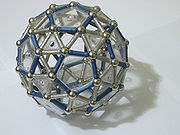
GEOMAG
Encyclopedia

Models are constructed by magnetically connecting the rods and spheres together in a lattice formation. Homemade experiments show that each stick can produce up to roughly 4.116N of force
Force
In physics, a force is any influence that causes an object to undergo a change in speed, a change in direction, or a change in shape. In other words, a force is that which can cause an object with mass to change its velocity , i.e., to accelerate, or which can cause a flexible object to deform...
when attracting iron. Builders report that construction of ceiling-high pendulums is possible.
Structures can easily be built and taken apart making building complex structures relatively easy. Such exercises teach children important lessons about problem solving, creativity, and physics. Geomag was named the 2005 Toy of the Year by the Toy Industry Association.
They are also a popular office executive toy
Executive toy
An executive toy is a novelty item that is usually a small mechanical gadget placed on the desk of a corporate executive or other office workers...
and increasingly used in more serious mathematical and scientific presentations.
Geomag updated its line by introducing the new Geomag Gift Range in early 2006. This new Premium line comprises special colored rods - and either Makrolon polycarbonate panels from Bayer Material Science AG, or rare Wengé Wood panels. These are no longer available.
In late 2009, Geomag changed and reorganized its line into three categories: GBaby, Geomag Kids, and Geomag Pro. The GBaby line contains large magnetic geometric and animal shapes suitable for babies as young as 10 months. The Geomag Kids line has rods that are longer than the original rods (58mm vs. 27mm) suitable for kids as young as 3 years. The Geomag Pro line is a continuation of the classic Geomag pieces, with new color themes, suitable for ages 6 through adult. The Geomag Forum was also newly restarted, providing a place for Geomag enthusiasts to exchange pictures and ideas.
There are several other toy systems similar to Geomag, many of which seem to be compatible with Geomag but in reality are not totally compatible due to the precise length of bar needed to create true geometric forms which are consistent and stable.
For example:
- Madmag
- Magic Joint
- Magmax
- MagnetixMagnetixMagnetix was a magnetic construction toy consisting of a combination of plastic building pieces containing embedded neodymium magnets, and steel bearing balls which can be connected together to form various geometric shapes and structures...
- MagnextMagnextMagnext is a magnetic construction toy consisting of plastic building pieces containing embedded neodymium magnets, steel bearing balls, and a variety of additional parts which can be connected together to form anything from skeletal geometric shapes and structures to more robust and functional toys...
- Magstix
- Magz
- Supermag *
- Xmag
* Prior to 2003 Supermag and Geomag were both produced by PlastWood, an Italian company. In 2003 PlastWood discontinued the Geomag line in favor focusing on its Supermag line, which the company felt to be more versitile.
Some of the above have added features, such as bars of differing (or even adjustable) length, curved bars, or bars connecting to three or more spheres.
Most magnetic ball and bar systems have a few weaknesses. Any vertex ball with many magnets attached usually needs some of them flipped to balance the North and South forces of the connections for maximum strength. The magnets add a lot of weight to a structure, limiting the maximum size that can be built. The balls allow bars to spin and shift freely, so the structure either needs extra supporting beams or panels to hold its shape.

